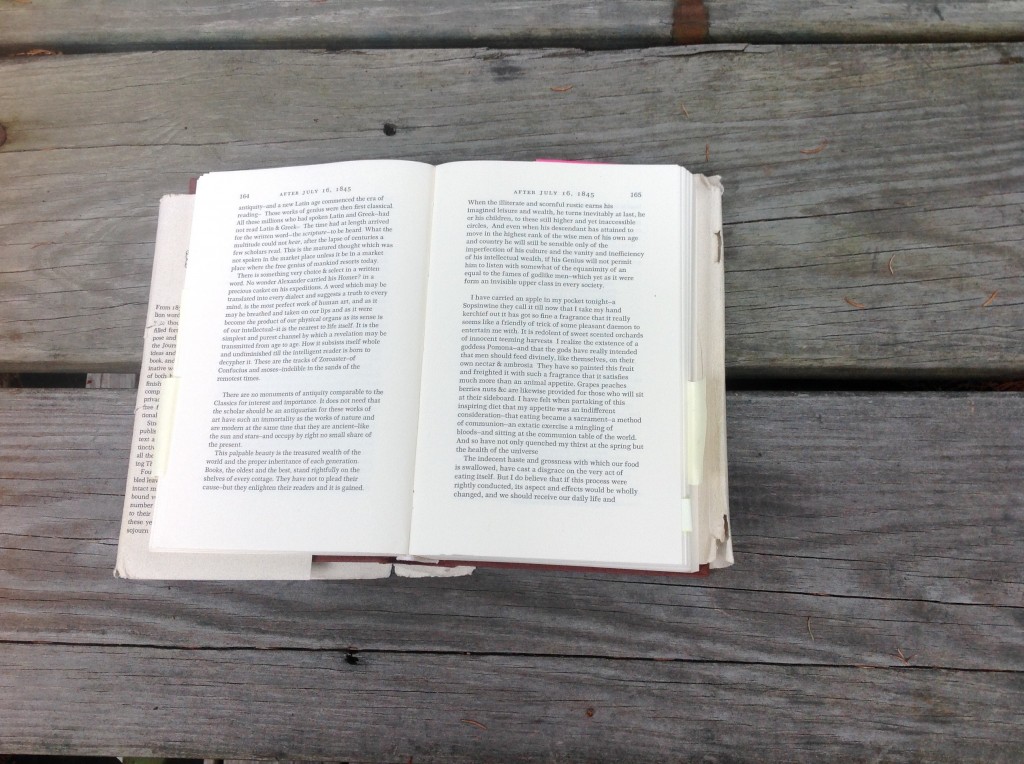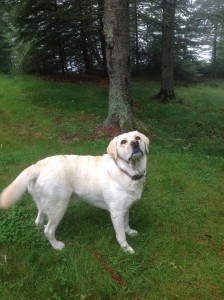“…this time we chose the right hand or highest peak – and soon my companions were lost to my sight behind the ver retreating mountain ridge over huge rocks loosely poised I climbed a mile or more – still edging toward the clouds…” Thoreau, Journal – Fall 1846
Thoreau’s summer of ‘46 was filled with mountains; his journal is rife with them – New Hampshire’s high peaks and Maine’s wild ones. In late summer, Thoreau was drawn north to the big woods and uplands of Maine. His second summer at Walden had brought both heat and, I’m guessing, a little flattening of both experience and “experiment.” Some nord-walking must have seemed just the restorative ticket.
Traveling counter-direction to Thoreau, but just as interested in restorative walking, I recently drove south from Maine. In Connecticut on a family visit, I rose early on an August day and, after a quick trip to a coffee shop, laced on my shoes. It was one of those morning’s where the cool air promises September, even as the sun announces an August intent. I figured a few hours of trail-time in those early hours would set up the rest of my day.
And so I drove a few miles to a favorite state park and turned into a three-car parking indent striated with tree roots. Sleeping Giant State Park runs about three miles on an west-east axis, and that axis follows the contours of a supposedly recumbent giant, whose various prominences – hip, knee, shoulder – rise some 500 feet above the valley below.
The Giant, tree-softened in sleepy profile when seen from a distance, is hard-boned up close. Along its steepnesses the trails are rock studded with the slough of ridges, and those fractured trap-rock stones are sharp-angled rather than water-smoothed geometries. And along its south-facing aspect, the Giant’s central body is shot also with hundred-foot cliffs; because we are some miles north of the long final moraine that is Long Island, I wonder if those cliffs are where the recent glacier tore chunks of Giant away and carried them south.
The Giant’s other notables are trees – in places oaks, maples, beeches and ashes soar to a canopy so high and complete that there’s almost no understory; in other spots groves of laurels rise like twisting smoke to 20 or 25 feet, where they spread leafily out.
Then there are the sightings: as I ran the broad gravel Tower Road up to the 739-foot high point, two twenty-somethings with buzzed, orange-tinged hair warned me that they’d just seen a copperhead on the path and that thought juiced the day with a little added wonder. Yes, I thought, we are along the northern fringe of copperhead range; yes that’s possible, even though it is improbable (their mohawks undercut somewhat their naturalist creds). “That’s so cool,” I said and kept on uphill, scanning now for coppery movement. I’m not sure what response they were after or expected, but my enthusiasm for the snake didn’t seem a match for it. “Silver hairs running up hills,” their expressions seemed to say. “What to make of them?”

Copperhead on the Sleeping Giant. photo credit: http://www.geofffox.com/MT/archives/tag/sleeping-giant
The best Giant loop – run first some years back after a dousing rain that left rivulets on the trails and drops sparkling in the trees – warms up along the lower perimeter of the park and then links two trails that traverse its flanks, running first west to east and then east to west. At its midpoint, this route adds the spike of running up the 600-foot climb to the prominence of the Giant’s left hip (with its rumored copperheads). My trails are, as are all trails on the Giant, color coded, the north flank’s marked by violet triangles, the south’s by yellow, and as I run I often follow the contours with the land sloping up above and away below my intermediate mountainscape.
Being in mid-Giant is the perfect level for focusing on my feet and not on what’s out or up there, the views and speculations that lift the head and bring on stumbles. Here, even – no, especially – amid the jumbled stone, I find rhythm; I step step step along through the big trees and splashed lime-colored light, along through the tumble of the Giant’s reclining body. And as we do wherever we run, I step step step into a country of myth.
Short summary of Giant myth: we come from the sea. And from the south, from New Haven’s harbor, the west-east traprock ridge some 10 miles inland looks like a recumbent being; that view from the coast gave rise to the Giant’s name. But the story returns as many do to those who went over this landscape for thousands of years before us. The New Haven area’s Quinnipiac Indians had a storied geography and a primary relationship with the long fluency of the Connecticut River. It seems also that their land was peopled by walking mountains, in particular one Hobbomock, who was ill-tempered as big beings tend to be. Anyway, Hobbomock conceived of a torment the locals wouldn’t forget; he set out to divert the huge nearby river, thereby disrupting the Quinnipiac’s way of life.
And in answer to their prayers and sacrifices, Hobbomock was finally quieted, given to sleep, where now he offers trails and little glens to those who would see the world at our feet.
Sometimes, the mythic brings us also back to the present.
Yo, look, Henry: it’s a copperhead!






